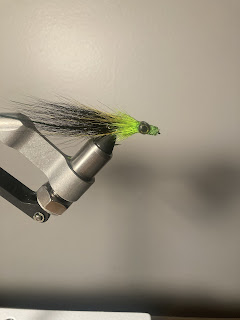Tying a weedless jerk fly
This is a pattern I just recently came up with that turned out pretty good. It’s on a weedless so you can fish it just about anywhere. I tied this fly with a tall jerk fly head which is best fished with a short steady strips and an occasional pause. When you stop stripping make sure you make your final strip harder than the rest that way the fly can use the momentum to turn and suspend. Usually jerk flies get most of their bites on the long pause so just be patient with this pattern.
Materials needed:
Thread
Streamer hook(preferably weedless)
Bucktail
Flash
Ep fibers
Craft fur
3d dome eyes
Step 1: start by wrapping about 6-8 turns of .020 lead wire around the hook shank. Follow this by wrapping over it with thread to secure it
Step 3: add whatever flash your going to use for this fly right on top of the bucktail. Tie the flash in to extend a little passed the bucktail
Step 4: move your thread slightly forward and tie in a sparse stacks of ep fibers on all sides of the hook shank. Make sure you have the most fiber on top of the hook to help the fly ride straight in the water. You will also want to make sure you get the sides even as well so the fly doesn’t tilt toward one side or the other. Tie the stacks in so that the fibers pointing toward the front of the hook are slightly shorter than the ones pointing back
Step 5: reverse the stacks of ep and bullet tie them so that they stay pointing rearward
Strp 6: move your thread up again and repeat the last step but use more ep fiber and only add stacks to the top and bottom of the hook. Make these stacks shorter and follow the same rules as last time(shorter fibers pointing forward longer pointing back) this will as the proper taper to the fly
Step 7: bullet tie the stacks of ep fiber again and the whip finish and comp out the fibers. This will free trapped ep fibers and make the fly more 3 dimensional. You will also want to take this time to do any trimming if you need to. If you do decide to trim it make sure you leave the top standing tall and the bottom swept back
Step 8: add some red bucktail to make a fill spot that will show through the head of the fly
Step 9: repeat step 7 but use craft fur instead. With this stack you will want to push your thumb on top of the craft fur so that it spreads to the sides of the hook as well. And remember to use more on top than on the bottom
Step 10: add another fill spot with the same bucktail to add more contrast to the head
Step 11: tie in another 3 stacks of craft fur one on top and one on the bottom. With these stacks make sure to use more craft fur but still keep the top more dense. This will add the proper bulk to the head of the fly that is needed to turn the fly and give it the jerking action. This stack is almost the same as the last one but this time just make sure your thread ends at the hook eye and make sure not to bullet tie it
Step 12: pull all of the craft fur rearward and pull your thread through the fur. Whip finish while holding the fur back and cut off your thread. Now the fur will be standing straight up as seen in the last step. You will now hold all the fur back and apply glue to just slightly touch the fur so it will stay pushed back but still have a wavy effect in the water. Add a little more to the bottom and pinch the sides to create a tall head and make a space for the eyes
Step 13: glue on 3d dome eyes in whichever size fits your fly.(if you used the 2/0 weedless hook I’m using an 8mm eye fits perfectly) make sure you glue the eyes on perfectly in line with each other so that the fly doesn’t lean toward on side. Also make sure you place the eyes more on top of the hook than the bottom while still keeping it on he side of the head. Once you have the eye placed on the side of the hook pinch the eyes together before the glue sets to make a thin tall head. This will finish the fly and it is ready to fish
This fly usually works best in spring and early summer when baitfish are swimming around. The eyes will help the fish you are trying to catch track your fly so if one breaks off make sure to add another one because it helps a lot more than you think.
If you liked this post please consider checking out our other posts

















Comments
Post a Comment